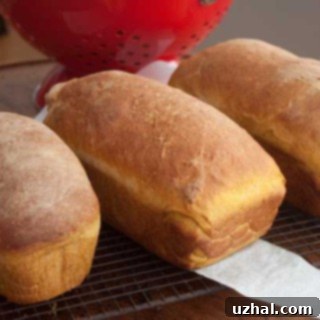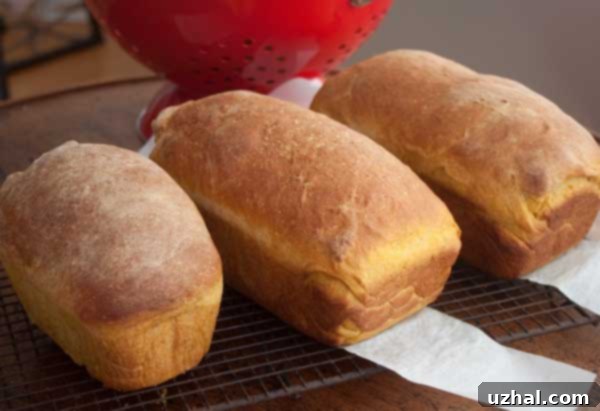Homemade Pumpkin Yeast Bread: Your Ultimate Fall Baking Companion for Sandwiches & Toast
There’s a special kind of warmth that comes with baking fresh bread, and when you infuse it with the comforting flavors of pumpkin and spice, you create something truly magical. This Pumpkin Yeast Bread isn’t just a recipe; it’s a celebration of autumn, a versatile staple, and a delightful contribution to any table. I originally prepared this fantastic bread for the Chicago Food Swap, an event that always brings together passionate home cooks and bakers, fostering a wonderful community spirit around shared culinary creations. If you’re in the Chicago area and love to experiment in the kitchen, I highly recommend checking out their events – it’s a fantastic way to meet fellow food enthusiasts and discover new favorites. And if you happened to be there when I brought this bread, I hope you enjoyed a slice!
Beyond Quick Bread: The Richness of Pumpkin Yeast Bread for Everyday Delights
Unlike a quick bread, which uses leavening agents like baking soda or powder, this recipe yields a genuine, yeasted pumpkin bread with a delightful chew and a complex flavor profile. It’s truly perfect for slicing and using as sandwich bread, or for toasting to a golden perfection. Imagine it slathered with butter, a dollop of cream cheese, or even jam – a simple pleasure that elevates any meal. The original foundation for this recipe comes from the trusted culinary experts at King Arthur, renowned for their reliable and detailed baking instructions.
One of the many strengths of this particular pumpkin bread recipe is its incredible flexibility. The generous amount of dough it produces can be transformed in various ways: you can bake two standard 9×5 inch loaves, or perhaps two slightly smaller 8×4 inch loaves plus a charming mini (3×5 inch) loaf. Alternatively, you might opt for one larger loaf and a whole batch of delicious pumpkin-flavored rolls. This adaptability makes it a simple yet impressive and somewhat unusual offering, perfect for sharing, gifting, or simply enjoying throughout the week.
Mastering the Dough: Tips for a Flawless Pumpkin Yeast Bread
Over the years, King Arthur has made slight alterations to their pumpkin yeast bread recipe, primarily to address feedback regarding the dough being too wet. My experience with the most recent version, using their recommended 27 ½ ounces of flour (and yes, baking with weights is always a game-changer for consistency!), was smooth sailing. While for a brief moment I thought the dough might lean towards the dry side, it ultimately came together beautifully without being overly wet. A pro-tip for any bread baker is to always reserve a small portion of your flour. This allows you to gradually incorporate it at the end, making adjustments as needed to compensate for variations in moisture, which can be affected by everything from the humidity in your kitchen to the brand of pumpkin puree you use. I highly recommend starting with King Arthur’s recipe as your guide and referencing my notes here for any specific questions or considerations. For this particular batch, I opted for bread flour instead of all-purpose, which contributes to a chewier texture and a more substantial crumb.
The Allure of Pumpkin in Baking
Pumpkin is more than just a seasonal flavor; it brings wonderful properties to yeast bread. Its natural moisture helps keep the bread tender and extends its freshness. The vibrant orange hue of the pumpkin puree naturally colors the bread, making it visually appealing, especially during the fall season. Beyond its aesthetic and textural contributions, pumpkin is also a good source of vitamins, adding a subtle nutritional boost to your homemade loaf. Paired with warm spices like cinnamon, nutmeg, ginger, and cloves (the typical components of pumpkin pie spice), the pumpkin truly shines, creating a comforting aroma that fills your home as it bakes.
Versatility in Every Batch: Loaves, Rolls, and More
As mentioned, this recipe is incredibly versatile. Whether you choose to bake large loaves for family meals, smaller loaves for gifting, or individual rolls for easy grab-and-go options, the result is always delicious. When shaping your dough, consider the occasion. Large loaves are excellent for slicing for hearty sandwiches, while rolls are perfect for dinner, breakfast, or even mini-sliders. You’ll end up with over three pounds of dough, offering ample opportunity to experiment with different forms. Don’t be afraid to divide the dough as suggested and try a combination of loaves and rolls to get the best of both worlds!
Essential Baking Tips for Success
- Measure by Weight: As emphasized, using a kitchen scale for flour (27 ½ ounces or 780 grams) ensures accuracy, which is crucial in bread baking. Volume measurements can vary greatly.
- Dough Hydration: Pay close attention to the dough’s consistency. It should be soft, pliable, and slightly tacky but not sticky. If it feels too dry, add water *very* sparingly, a teaspoon at a time. If too wet, a little more flour, again, gradually.
- Kneading: Kneading develops the gluten, giving the bread its structure. Whether by hand or with a stand mixer, knead until the dough is smooth, elastic, and passes the “windowpane test” (you can stretch a small piece thin enough to see light through it without tearing).
- Proofing Environment: A warm, draft-free place is ideal for rising. If your kitchen is cool, a slightly warmed oven (turned off!) or a sunny spot can help. The dough should double in size, indicating proper yeast activity.
- Checking for Doneness: The crust should be a deep golden brown. For an accurate measure, a digital thermometer inserted into the center of the loaf should read around 190°F (88°C). This ensures the bread is cooked through without being dry.
Serving Suggestions to Savor Every Slice
This pumpkin yeast bread is a true chameleon, adapting to many serving styles:
- Classic Sandwiches: Use it for turkey, ham, or even a robust veggie sandwich. The subtle sweetness of the pumpkin complements savory fillings beautifully.
- Breakfast Toast: Toast slices and spread with butter, cinnamon sugar, cream cheese, or your favorite jam. A drizzle of honey or maple syrup is also divine.
- French Toast: Transform day-old slices into an extraordinary French toast breakfast. The pumpkin flavor adds an extra layer of richness.
- Savory Accompaniment: Serve alongside a hearty bowl of chili, stew, or a creamy autumn soup.
- Sweet Treat: A slice with a cup of coffee or tea makes for a perfect afternoon pick-me-up.
Storage for Lasting Freshness
Once your pumpkin yeast bread has completely cooled on a rack, it’s essential to store it properly to maintain its freshness. Well-wrapped loaves or rolls can be kept at room temperature for several days. For longer storage, this bread freezes beautifully. Wrap individual slices or whole loaves tightly in plastic wrap, then aluminum foil, and store in the freezer for up to a few months. Thaw at room temperature or gently warm in the oven for that freshly baked taste.
This recipe is more than just food; it’s an experience. The smell of the spices, the tactile joy of working with the dough, and the ultimate reward of a warm, homemade loaf are all part of the journey. I hope you enjoy baking and sharing this delightful pumpkin yeast bread as much as I do!
- Soft Pumpkin Cream Cheese Cookies
- Another Great Pumpkin Bread Recipe
- Fresh Pumpkin Pie
- Whole Wheat Pumpkin Muffins with Coconut Oil
- Pumpkin Bars with Boiled Frosting
Pumpkin Yeast Bread Recipe

Pumpkin Yeast Bread
Pin Recipe
Ingredients
- 6 ½ cups King Arthur bread flour or all-purpose, preferably measured at 780 grams
- ½ cup packed light brown sugar 105 grams
- 2 ½ teaspoons salt
- 1 teaspoon pumpkin pie spice
- 2 packets instant “quick rise” yeast
- ½ cup lukewarm milk
- 2 large eggs
- 1 ½ cups canned pumpkin 330 grams, not pumpkin pie filling
- 2 tablespoons vegetable oil
Instructions
-
In the bowl of a stand mixer, combine 5 ½ cups of the flour, brown sugar, salt, pumpkin pie spice, and instant yeast. Mix briefly to combine these dry ingredients.
-
Add the lukewarm milk, eggs, canned pumpkin, and vegetable oil to the dry mixture. Stir on low speed until all ingredients are just incorporated and a shaggy dough forms.
-
Gradually add the remaining flour (up to 1 cup). Add it slowly, a tablespoon at a time, until the dough reaches the desired consistency – it should be soft and pliable, not overly dry or excessively sticky. If it appears very dry, add a tiny amount of water (half a teaspoon at a time).
-
Attach the dough hook to your stand mixer and knead the dough on medium-low speed for 7-10 minutes, or until it becomes smooth, elastic, and pulls away cleanly from the sides of the bowl.
-
Transfer the kneaded dough to a lightly greased bowl, turning once to coat. Cover the bowl with plastic wrap or a clean kitchen towel and let it rise in a warm, draft-free place for about 60 minutes, or until it has visibly doubled in size.
-
Once doubled, gently press down on the dough to release the air. Turn it out onto a lightly oiled (or floured, if preferred) work surface. You will have over 3 pounds of dough. Divide it into your desired sections for loaves or rolls.
-
Shape the dough: form into two 9×5 inch loaves, or two 8×4 inch loaves and a mini loaf, or shape into rolls. Place the shaped dough into prepared baking pans or onto baking sheets.
-
Cover the pan(s) again and let the loaves/rolls rise for a second time until almost doubled in size, which should take approximately 45 minutes. About 15 minutes before the end of the rising time, preheat your oven to 350°F (175°C).
-
Bake the bread for 30 to 35 minutes. The crust should be a beautiful deep golden brown, and when a digital thermometer is inserted into the center of a loaf, it should register approximately 190°F (88°C). Rolls will bake faster, around 20-25 minutes.
-
Carefully remove the bread from the oven and immediately turn it out onto a wire rack to cool completely. This prevents the bottom from becoming soggy. Store completely cool bread or rolls well-wrapped at room temperature for several days; for longer preservation, freeze them.
